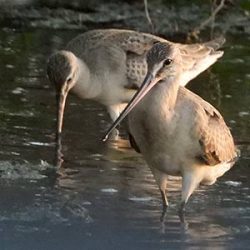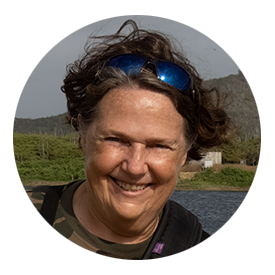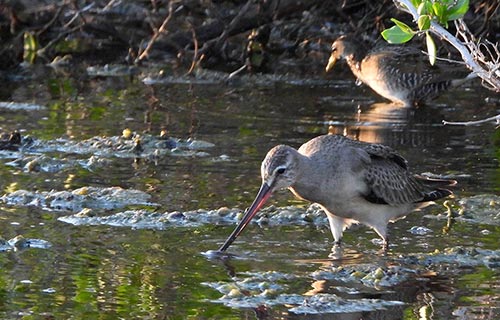Hudsonian Godwits Take a Migration Rest Stop on Bonaire.
Hudsonian Godwits undertake a long migration twice each year, from the sub-arctic all the way to the southern part of South America. Bonaire provides an excellent mid-way point for a well-deserved rest.
Posted October 2, 2019
Rare Hudsonian Godwits rest on Bonaire during their long, fall migration to South America.
This past weekend, I was absolutely thrilled to come across a pair of Hudsonian Godwits, considered a rare sighting on Bonaire.
This pair of godwits were in a freshwater pond created by recent rains, along with other migrating shorebirds, most of which were Stilt Sandpipers.
Hudsonian Godwits can migrate long distances.
After breeding during the summer months in the sub-arctic of North America, the Hudsonian Godwits begin their fall migration to the southern parts of South America. On this long trip, they apparently make non-stop flights of several thousand miles.
Bonaire is the perfect half-way point for them to stop and rest and recover before continuing on to the southern hemisphere.
How to identify the Hudsonian Godwit.
Historically recorded sightings of the Hudsonian Godwit.
According to eBird, the first recorded observation of this bird on Bonaire was in 1983, and until today, only eight additional sightings have been recorded, the most recent of which was in 2017.
It appears that the Hudsonian Godwit, if sighted at all, can be most easily observed during the fall migration, but they do not appear to be observed during the spring migration back to the north.
Quick Facts about the Hudsonian Godwit.

Hudsonian Godwit
(Limosa haemastica)
Diet: Aquatic invertebrates
Breeding: Lays 2 to 4 eggs
Status: Least Concern, but the population is diminishing
About the author
Susan has been living on Bonaire for over 30 years. She is a certified bird guide, a PADI SCUBA Diving Master Instructor, and an underwater and topside photographer.

Get in touch with Susan
Contact Susan via email, Facebook Messenger, call Susan or use the online form below.
If you have any questions about your Bonaire birding tour, feel free to contact Susan for answers. She is always willing to go into more detail about routes or the best times for a tour based on your personal preferences. Tours can be tailored to your interests, whether that be birds, photography, or both!
It is also a good idea to do some homework on the birds of Bonaire before you come. Knowing a little about the birds you might encounter on your tour will make your experience even more enjoyable!
Be sure to check out these resources for birding on Bonaire. Also, reading the Bird Blog will introduce you to the birds that might be observed on Bonaire.
Get In Touch
Get in touch with Susan to check availability for the dates you are visiting Bonaire.
Consent: By using this form you agree with the storage and handling of your data by this website.



